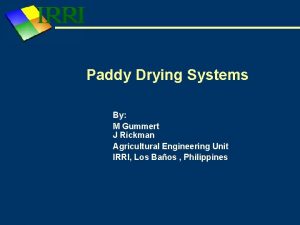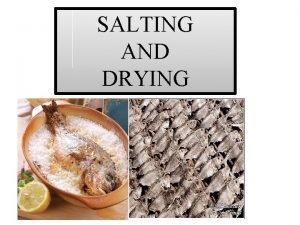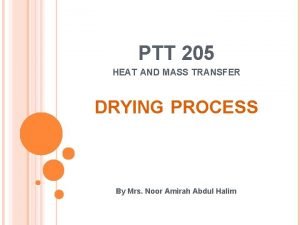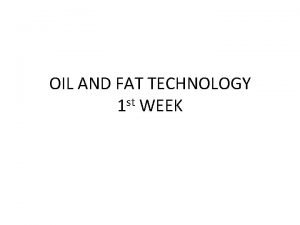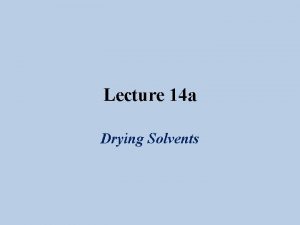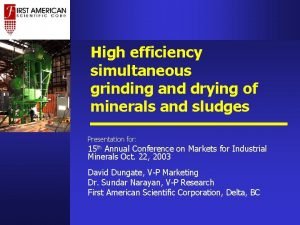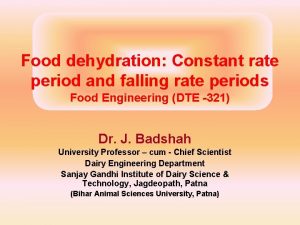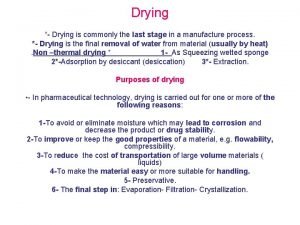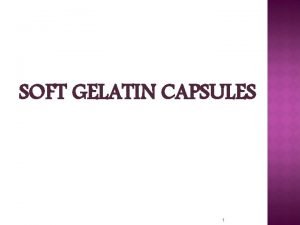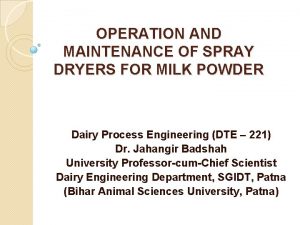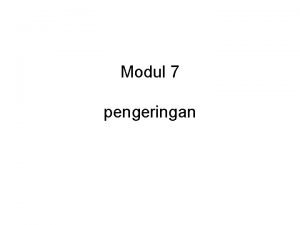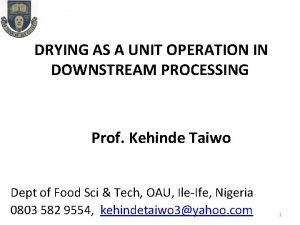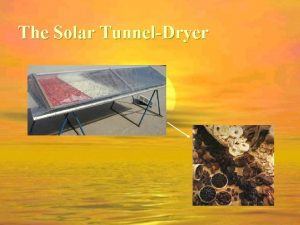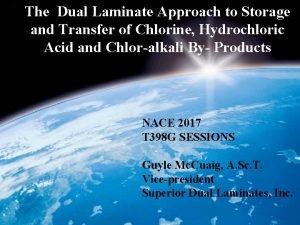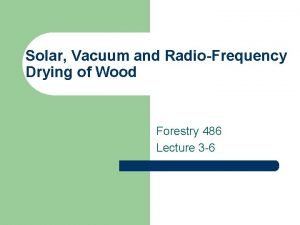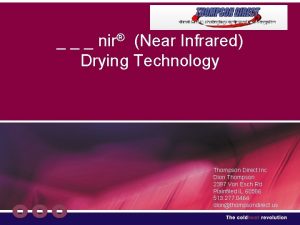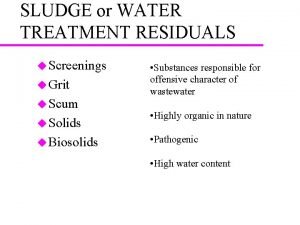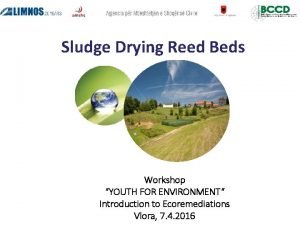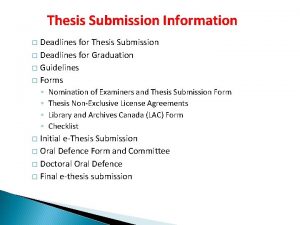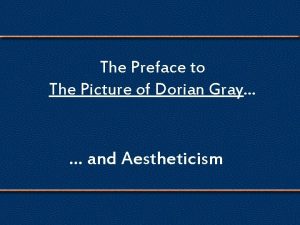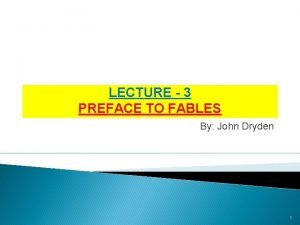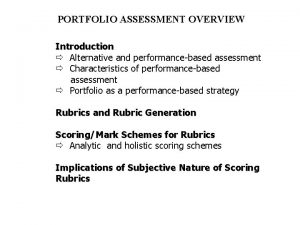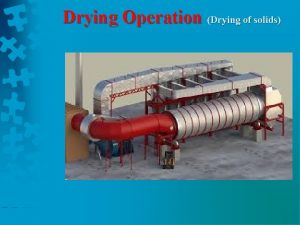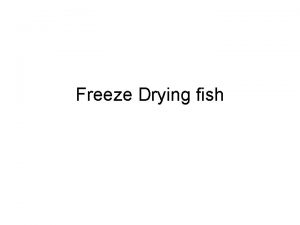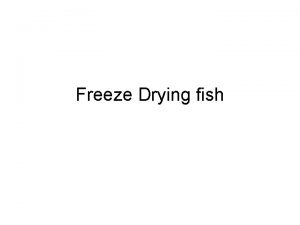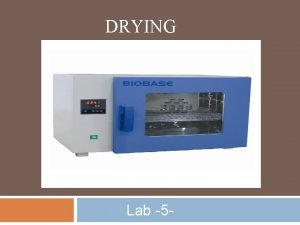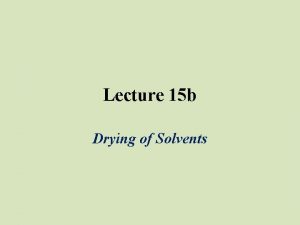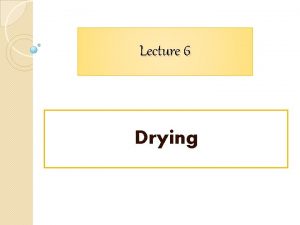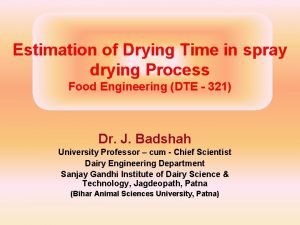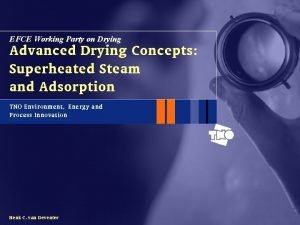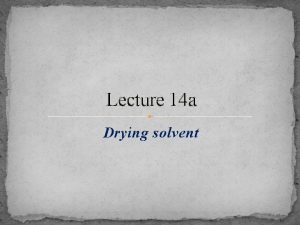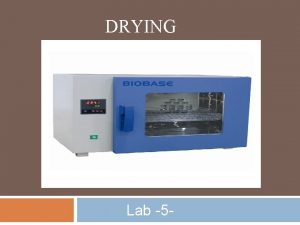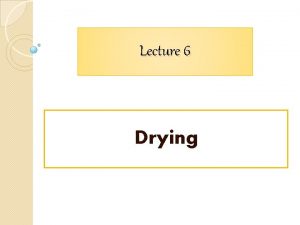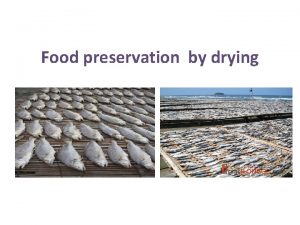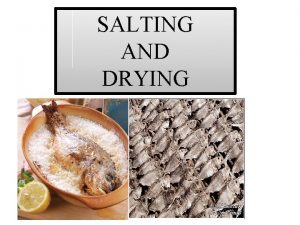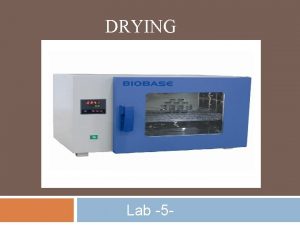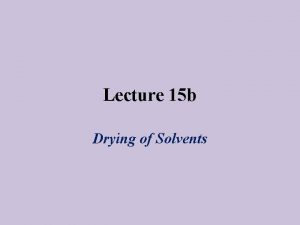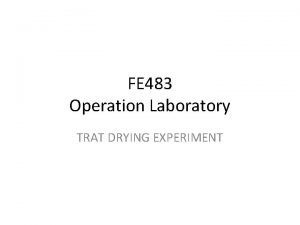14 1 Introduction Preface 1 In general drying


































- Slides: 34

§ 14. 1 Introduction 一、Preface 1. In general, drying a solid 一、前言 就一般而言,固体干燥 means the removal of 意味着从固态物中去除相对 relatively small amounts of 含量少的水份或其它液体, water or other liquid from 以使固态物中剩余的液体含 the solid material to reduce 量减少到可接受的值。 the content of residual liquid to an acceptably low value. 给出了干燥目的

2. Drying is usually the final 通常,干燥是一系 step in a series of operations, 列单元操作中的最后一 步。从干燥器出来的产 and the product from a dryer 品往往可直接进行包装。 is often ready for final 去除固体中的水份或其 packaging. Water or other 它液体可通过挤压、负 liquids may be removed from 压或离心等机械分离方 法,也可通过加热汽化 solids mechanically by 的方法。 presses or centrifuges or thermally by vaporization. 液体除去的方式

3. This chapter is restricted to 本章仅限于对加热 drying by thermal 汽化干燥方法的讨论。 vaporization. It is generally 一般而言,去除固体中 cheaper to remove liquid 的液体,机械法要比加 mechanically than thermally, 热法廉价。因此,建议 and thus it is advisable to reduce the liquid content as much as practicable before feeding the material to a heated dryer. 在物料进入干燥器之前, 应尽可能的先通过机械 方法降低该物料中的湿 含量。 机械法和干燥法比较

4. The liquid content of a dried 干燥后的固体物其湿含量 substance varies from product 高低因产品而异。偶尔也有不 to product. Occasionally the product contains no liquid and is called bone-dry. More commonly, the product does contain some liquid. Dried table salt, for example, contains about 0. 5% water, dried coal about 4%, and dried casein about 8%. 含湿份的产品。这种物质被称 为绝干物质。更为一般的情况 是干燥后仍然具有一定的湿含 量。例如,干燥后的食盐仍含 有大约 0. 5%的水份,干燥后的 煤碳仍含有大约 4%的水份,干 燥后的酪素仍含有约 8%的水份。 干燥结果

5. Drying is a relative term and 干燥实际上是一个相 means merely that there is a 对的概念,即只是把固形 reduction in liquid content from an initial value to some acceptable final value. The solids to be dried may 物中的湿份从初值降低到 be in many different forms flakes, granules, crystals, powders, slabs, or continuous sheets and may have widely differing properties. 可接受的终值。 被干燥的固形物可具 有多种形状,例如薄片状、 粒状、 结晶状、粉末状、 板状和页状等,且具有广 泛的不同物性。 被干燥物料的性质

6. The liquid to be vaporized 被汽化的湿份可以 may be on the surface of the 附着在固形物的表面, solid, as in drying salt crystals; it may be entirely inside the solid, as in solvent removal from a sheet of 例如晶体盐的干燥过程 ;也可以全在固体内部, 例如从页状聚合物中去 除溶剂;也可以是部分 polymer; or it may be partly outside and partly inside. The feed to some dryers is a liquid in which the solid is suspended as particles or is in solution. 在表面,部分在内部。 进入某些干燥器的物料 其固形物或以颗粒的形 式悬浮在液体中,或是 均相的溶液。

7. The dried product may be able 待干燥的产品有 to stand rough handling and a very 的可经受高温环境下 hot environment, or it may require 的苛刻操作,有的则 要求在低的或适中温 gentle treatment at low or 度下的温和操作。 moderate temperatures. 因此,市场具有 Consequently a multitude of 可用于实际生产的各 for commercial drying. They differ 类干燥器。它们的区 别主要是固体通过干 chiefly in the way the solids are 燥区的方式不同和加 moved through the drying zone 热方式的不同。 and in the way heat is transferred. types of dryers are on the market

二、 Classification of dryers 1. There is no simple way of 干燥器分类 对干燥装置并 无简单的分类方法。 Some dryers are continuous, and 有的干燥器可连续 操作,有的则是间 others operate batchwise; some 歇操作;有的需要 agitate the solids, and others are 搅动固形物,有的 essentially unagitated. Operation 则基本不需要。为 under vacuum may be used to 了降低干燥温度, reduce the drying temperature. 还可在真空条件下 操作。 classifying drying equipment.

3. (2) dryers in which heat is 第二类干燥器:在 transferred to the solid from 干燥器中,热量是由外 an external medium such as 部介质诸如正在冷凝的 condensing steam, usually 物流提供,以导热方式 through a metal surface with 通过金属壁面传递给待 干燥的物料。物料与金 which the solid is in contact 属壁面直接接触;第三 , and (3) dryers that are 类干燥器: 以介电、 heated by dielectric, radiant, 辐射或微波等方式提供 or microwave energy. 能量。

2. Some dryers can handle 有些干燥器几乎可 almost any kind of material, 处理任何一种物料,而 while others are severely 有些则局限于被干燥物 limited in the type of feed they can accept. Major divisions may be made 料的类型,即它们能够 接受的操作条件。一般 而言,对干燥器可作如 下划分:第一类干燥器: among (1) dryers in which 固体在干燥器中直接暴 the solid is directly exposed 露于热气体(通常是热 to a hot gas (usually air); 空气)中的干燥器;

4. Dryers that expose the 固体暴露于热气体 solids to a hot gas are called 中的干燥器称为绝热 adiabatic or direct dryers; 式或直接式干燥器; those in which heat is 热量由外部介质提供 transferred from an external 的干燥器被称为非绝 medium are known as 热式或间接式干燥器。 nonadiabatic or indirect 有些干燥操作是将绝 dryers. Some units combine 热和非绝热过程组合 adiabatic and nonadiabatic drying; they are known as 在一起的。 这类干燥 器被称为直接—间接 direct-indirect dryers. 式 干燥器。






三、 Solids handling in dryers 干燥器中的固体处理 1. Most industrial dryers 大多数 业干燥 handle particulate solids 器以部分循环或全循 during part of or all the drying 环方式干燥颗粒状固 cycle, although some, of course, 体,自然,也可干燥 dry large individual pieces 较大的物件,例如陶 such as ceramic ware or sheets 瓷制品或聚合簿膜。 of polymer. The properties of 关于固体颗粒的性质 particulate solids are discussed 将在第 28章中讨论。 in Chap. 28.

2. Here it is important only to 固体颗粒通过 describe the different patterns of 干燥器的不同运动 motion of solid particles through 方式是理解下一节 将要讨论的干燥原 dryers as a basis for understanding the principles of drying discussed in the next section. In adiabatic dryers the solids are exposed to the gas in the following ways: 理的基础。因此, 只对其进行描述是 重要的。在绝热干 燥器中,固体以下 列方式暴露于加热 气体中:

FIGURE 24. 1 Patterns of gas-solid interaction in dryers: (a) gas flow across a static bed of solids; (b) gas passing through a 图 24. 1气固相在干燥器中 的作用方式: (a)气体吹过静止固体床层 ; bed of preformed solids; (b)气体穿过事先已成型的

(c) showering action in a (c)固体在转鼓干燥器中洒落; rotary dryer; (d) fluidized solids bed; (d)固体流化床干燥; (e) cocurrent gas-solid (e)气固相并流气动传输快速 flow in a pneumatic干燥器。 conveyor flash dryer.

⑴ Gas is blown across the ⑴气体可吹过固体床层 surface of a bed or slab of 表面或固体颗粒面,也 solids or across one or both 可单面或双面吹过一个 faces of a continuous sheet or 连续的薄片或膜。这一 film. This process is called 干燥过程称为盘式循环 cross-circulation drying . 干燥。

⑵ Gas is blown through a bed ⑵气体穿过由筛网支 of coarse granular solids that 撑的质地粗糙的固体 are supported on a screen. This is known as through-circulation drying. As in cross-circulation drying, the gas velocity is kept 颗粒床层。这就是所 谓的穿流循环干燥。 与盘式循环干燥一样, 应保持低气速操作, low to avoid any entrainment of 避免夹带固体颗粒。 solid particles (Fig. 24. 1 b).

⑶ Solids are showered downward through a slowly moving gas ⑶固体颗粒如同淋浴 stream, often with some 般穿过缓慢移动的气 undesired entrainment 流。此气流中往往会 of fine particles in the 有一些不希望夹带的 gas (Fig. 24. 1 c). 细小微粒 。

⑷ Gas passes through the solids at a velocity sufficient to fluidize the ⑷正如在第七章中所 bed, as discussed in Chap. 讨论的,气体以足以 7. Inevitably there is some 使床层流态化的流速 穿过固体。显然气体 entrainment of finer 也会不可避免地夹带 particles (Fig. 24. 1 d). 一些微细颗粒。

⑸The solids are all entrained in a highvelocity gas stream and are pneumatically conveyed from a mixing device to a mechanical separator (Fig. 24. 1 e). ⑸待干燥的固体被高速 气流夹带着,以气动输 送方式由混合装置进入 分离器。

3. In nonadiabatic dryers the 3. 在非绝热干燥器中, only gas to be removed is the 虽然,有时也有少量的 vaporized water or solvent, although sometimes a small amount of "sweep gas" (often air or nitrogen) is passed through the unit. Nonadiabatic dryers differ chiefly in the ways in which the solids are exposed to the hot surface or other source of heat. 吹扫气(通常是空气或 氮气)吹过装置,但去 除的气体仅仅是汽化的 水或溶剂。非绝热干燥 器与绝热干燥器的主要 差别是待干燥固体是与 加热表面接触或与其它 类型的热源接触。

a. Solids are spread over a a. 待干燥固体被铺散 stationary or slowly moving 在静止的或缓慢移动 horizontal surface and "cooked" 的水平加热面上,烘 干为止。这个面可以 until dry. The surface may be 用电加热,也可以用 heated electrically or by a heat诸如蒸汽或热水这一 transfer fluid such as steam or 类能够传热的流体加 hot water. Alternatively, heat 热。当然,也可通过 may be supplied by a radiant 热辐射的方式在固体 heater above the solid. 上方加热。

b. Solids are moved over a b. 待干燥固体在搅拌器或 heated surface, usually 螺旋式、桨式传输器作用 cylindrical, by an agitator or 下在外加热面上移动。该 a screw or paddle conveyor. c. Solids slide by gravity 面往往是圆柱形的。 over an inclined heated c. 固体或者在重力作用下 surface or are carried 沿着倾斜的加热面下滑一 upward with the surface for 段时间,或者被加热面携 a time and then slide to a 带着向上移动一段时间而 new location. (See “Rotary 到达一个新的位置。 Dryers, p 797”)


四、Conclusions 1. Methods of removing liquid content carried solids a. Mechanical Separations For example:Filtration, Clarify, Centrifuges; b. Adsorption By drying agent or medium : Ca. Cl 2, 硅胶. c. Thermal by vaporization Offering heat: Conduction ~ Drying with heat conduction Convection ~ Drying with convection Radiation

四、Conclusions 2. Drying medium & Moisture a. Drying medium In general, b. Moisture: Water air heated ; 3. This chapter discusses drying process with heat convection by air heated to remove water or moisture. Wet air characters ∴Three key problems: Moisture characters Drying rate

四、Conclusions 4. Drying process and their features a. Drying process with convection in pneumatic conveyance For air : 从 0 → 1:增温保湿的过程; 从 1 → 2:降温增湿的过程。 For solids : 从 1 → 2:增温减湿的过程。 0 1 2

四、Conclusions 4. Drying process and their features b. Benefits Air is heated: t↑ → 传热推动力 ↑ → Good pw ↑ → Good 影响两个方面: Mass transfer driving force↑ 热空气携带水分的能力↑ 加热空气:提高了空气的干燥能力。

四、Conclusions ∴Features: ⑴ Intimate contact with both heated air and solids; ⑵ Mass and heat transfer occur synchronically but directions oppositely.
 Similarities of field drying and panicle drying
Similarities of field drying and panicle drying Drying and salting
Drying and salting Constant and falling rate period of drying
Constant and falling rate period of drying Triglycerides
Triglycerides Drying solvents
Drying solvents Kds micronex
Kds micronex Falling rate period
Falling rate period Advantages and disadvantages of lyophilization
Advantages and disadvantages of lyophilization Drying rate formula
Drying rate formula Soft gelatin capsules
Soft gelatin capsules Dairy spray dryers
Dairy spray dryers X2xc
X2xc Drying in downstream processing
Drying in downstream processing Solar tunnel dryer for drying coconuts
Solar tunnel dryer for drying coconuts Chlorine drying tower design
Chlorine drying tower design 3 stages of clay
3 stages of clay Rfv kiln
Rfv kiln Is chopping wood a chemical reaction
Is chopping wood a chemical reaction Drying technology
Drying technology What organ is responsible for drying out indigestible food
What organ is responsible for drying out indigestible food What is lyo
What is lyo Sludge drying beds
Sludge drying beds Sludge drying reed beds
Sludge drying reed beds Another word for freeze drying
Another word for freeze drying Thesis defense introduction script
Thesis defense introduction script Preface of dorian gray
Preface of dorian gray Miss julie naturalism
Miss julie naturalism Dryden preface to the fables
Dryden preface to the fables Introduction harry potter
Introduction harry potter Book preface example
Book preface example Behind the scenes preface
Behind the scenes preface Preface
Preface Sustainability pillars
Sustainability pillars Preface example for portfolio
Preface example for portfolio Planos en cinematografia
Planos en cinematografia
